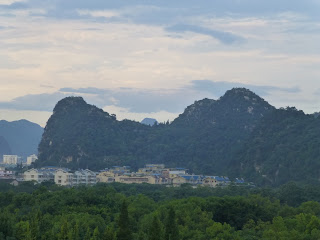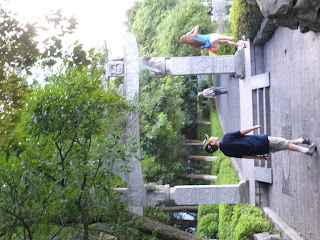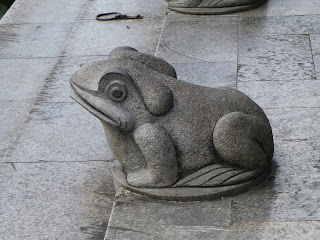The area around Yangshuo, China, is absolutely drop-dead gorgeous. Let your jaw hang open, lose your breath, feel your skin develop goosebumps, just plain beautiful. I only wish that I was a professional photographer so that my pictures would do the area justice. But these will have to do...
We arrived via plane from Xian on the late afternoon of August 18th. Although we had tried to get a through train ticket from Dunhuong, it wasn't feasible without going back to Beijing, or going through Shanghai, neither of which we wanted to do. So, we compromised and took the overnight train for the first part of the journey and missed the rugged scenery of the Szechuan mountains in the second.
Our first view of the
karsts - (yes, click on the link, I thought it was a Chinese word, too!) came as the taxi sped down the highway from the airport. Our driver laughed at our eyes. "Are you going to Yangshou? he asked? "A trip down the Li River is much more beautiful." He was right.
After dropping our bags off at the youth hostel, we set out on a walk. Guilin is an industrial city, slightly run down at the heels, with not too much to see. Its history is impressive, dating back at least 2000 years, if not more. Most recently, it was where Sun Yat-Sen established his military HQ while fighting against Mao Tse Tong. Although highly industrial, it is trying hard to convert itself back into a tourist destination.
We spent the early part of the evening walking around the lake and visiting the two pagodas. Our first stop was Banyan lake:
 |
| Men fishing. I think they were catching and releasing, but I am not entirely sure. The water didn't seem to be terribly clear. |
Banyan Lake was constructed out of a moat that surrounded the city during the Tang Dynasty In the center are two pagodas: the Sun and the Moon Pagodas. The walk is very popular - in fact, it is one of the nicer places to get away from crowds and cars. The Sun pagoda is the tallest copper pagoda in the world at 9 stories high.

 |
| N. is our map expert. |
 |
| Small figure in the courtyard of the Sun Pagoda. |

 |
| View from the top of the Sun Pagoda towards the Li River |
 |
| I think that this is Samantabhadra Tower, but am not sure: in any case, it can be seen from the top of the pagoda. |
 |
| Pagoda roof details - notice the odd (5) number of figurines. They never come by pairs. |
 |
| Nicholas at the top of the Moon pagoda |
 |
| The Sun Pagoda |
 |
| One of the buddhas in the Sun Pagoda. |
 |
| Looking down on the Moon Pagoda. |
 |
| The Sun (r.) and the Moon Pagoda in the background. |
 |
| The lion, a feng shui symbol ( here in front of a bank,) drives away evil spirits in order for prosperity to flourish. |
 |
| A view of the pedestrian center |
As the sun set, we found a restaurant for dinner. No English on the menu, but the pictures were fairly accurate. We did eat quite well.
After dinner, we visited a tea shop run by the restaurant owner's wife. The family farm is about 100 kms outside the city. We ended up taking some fruit flavored black tea. But the real score was to see the samples of Pu'erh tea - this is a fermented tea that is seasoned for many years. The larger ball is about 10 years old, the rectangular bricks are 20-30 years old. This is a robust tea, good for cold winter nights. I can't wait!
The next day we were to leave our hostel early in the morning to take a bus to a boat for a 4 hour sail down the Li River. We were promised extraordinary views. Judging by what we saw from the top of the pagodas, we would be in for a marvelous day.
































No comments:
Post a Comment